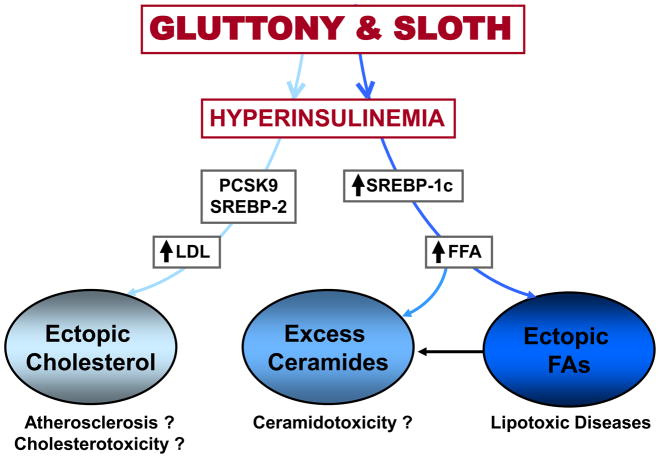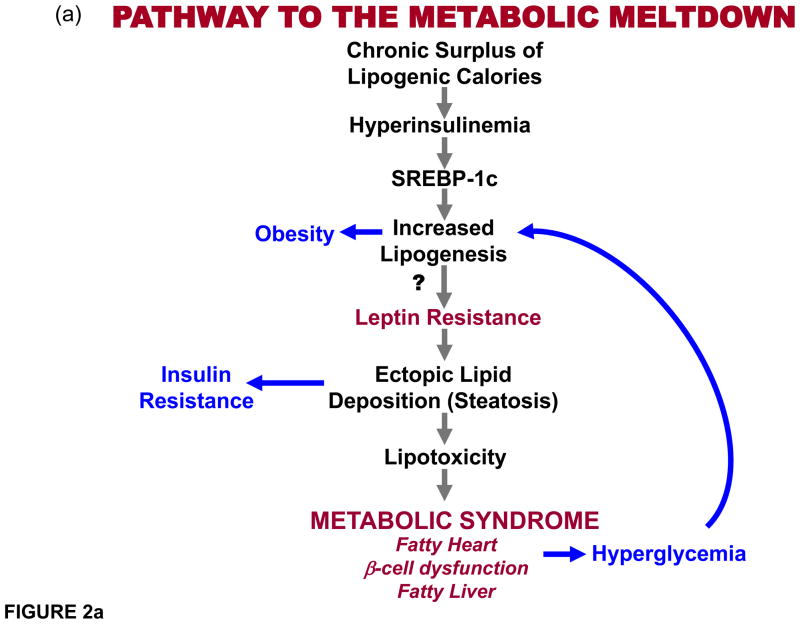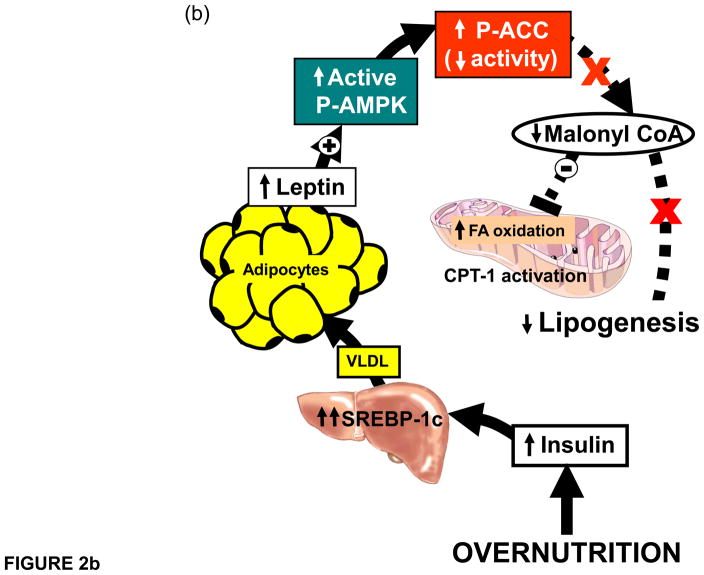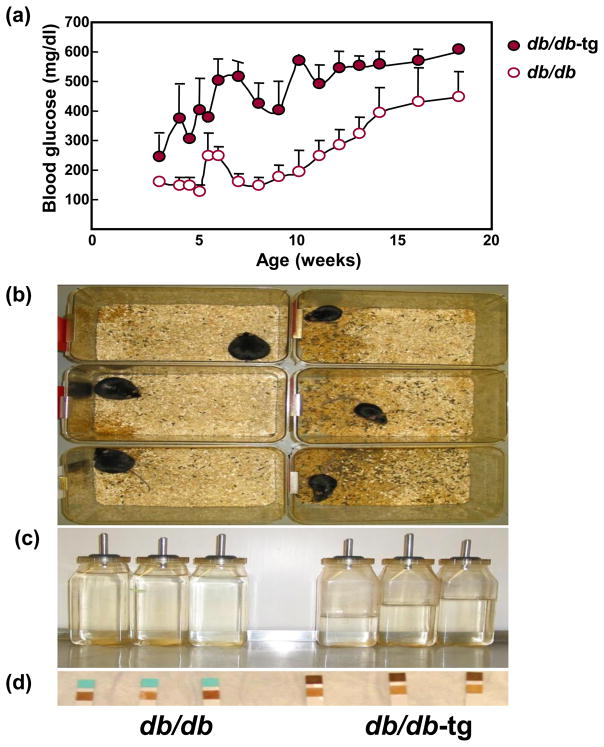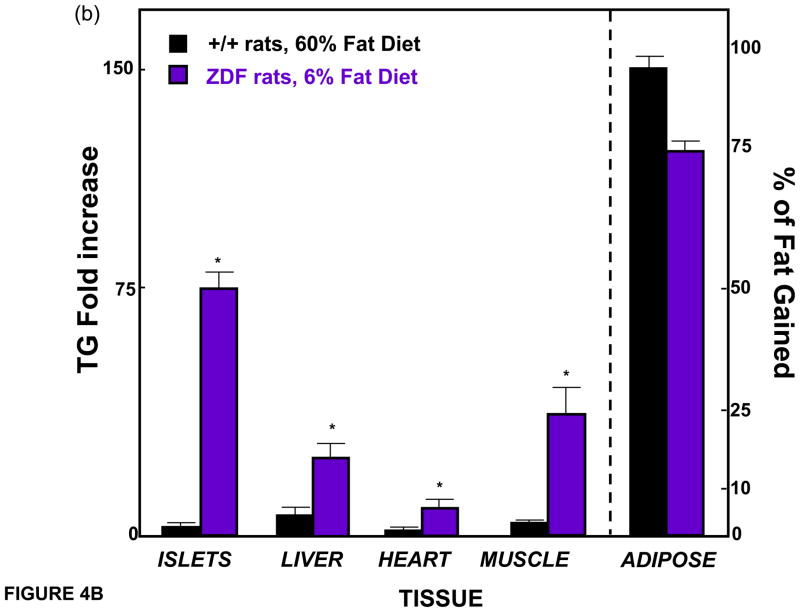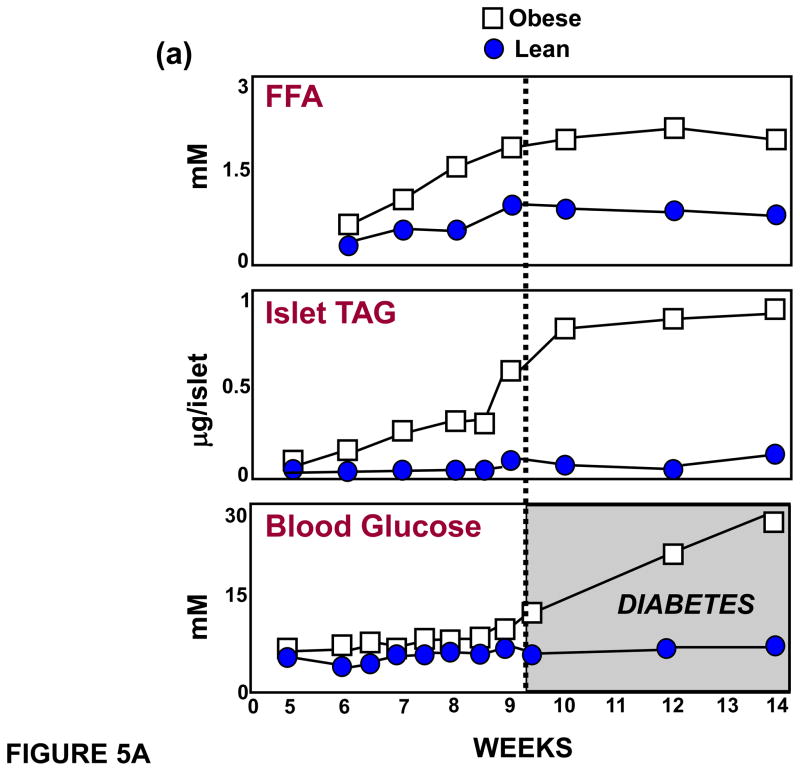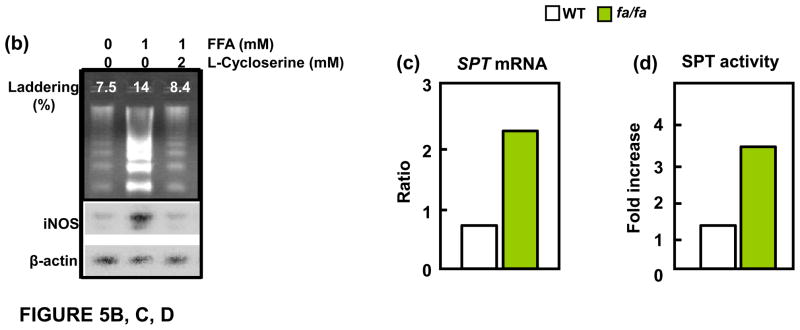Abstract
Once considered divine retribution for sins, comorbidities of obesity (metabolic syndrome) are today attributed to obesity-induced metabolic defects. Here we propose that obesity and hyperleptinemia protect lipid-intolerant nonadipose organs against lipotoxic lipid spillover during sustained caloric surplus. Metabolic syndrome is ascribed to lipotoxicity caused by age-related resistance to leptin’s antilipotoxic protection.
“The wrath of God came upon them, and slew the fattest of them…” 7 —
8th Psalm, Verse 31.
Introduction
Diet-induced obesity has existed throughout human history, although until recently it was a relatively rare condition associated with affluence. In biblical times its high mortality rate was ascribed to divine retribution, but today alternative explanations for the co-morbidities of obesity, generally referred to as the metabolic syndrome, are entertained. In the sixth century A.D. seven cardinal sins were identified and two of them, “gluttony” and “sloth”, a.k.a. overnutrition and underexertion, also happen to be the cardinal causes of the metabolic syndrome. In this review we examine new concepts and scientific advances that link overeating and inactivity to the metabolic syndrome via biologic mechanisms (Figure 1).
Figure 1.
A biological explanation for the morbid and mortal consequences of a gluttonous and slothful lifestyle, implicating nutrient-induced upregulation of lipogenesis, cholesterologenesis and ceramidogenesis to the point of lipotoxicity. It should be pointed out that cholesterolotoxicity has not been demonstrated to occur spontaneously, but could exist (?) based on diabetes caused by transgenic overexpression of SREBP2 in β-cells [48]. Ceramidotoxicity, a potentially important metabolic aberration [49], is also not clearly identified in metabolic syndrome, but has been demonstrated to occur spontaneously in islets of ZDF rats with T2DM and metabolic syndrome [38].
The lethal consequences of co-morbidities of obesity can actually be “Darwinized” to explain the evolution of genes such as proprotein convertase subtilin/kexin type 9 (PCSK9), the only known function of which is to degrade the LDL receptor and thereby increase LDL-cholesterol [1] in individuals who consume an atherogenic diet. If its only function is to increase risk of heart disease, could this signify that collective survival is protected at the expense of individual survival? Could elimination of gluttonous and slothful members of a society after their reproductive years assure the youngest members of the group a fair share of food during times of limited supply?
The hypothetical gluttonicidal pathway depicted in Figure 1 would fit into this paradigm. It is depicted to have a lipotoxic arm, well-established in rodents and humans, and hypothetical cholesterolotoxic and ceramidotoxic arms, each of which could result in potentially lethal disease caused by ectopic lipid deposition. Ectopic cholesterol deposition in coronary arteries is a familiar cause of morbidity and mortality in the Western world, but is uncommon in populations that have not been exposed to high saturated fat diets [2]. Similarly, the lipogenic arm has been proposed as a cause of the metabolic syndrome in persons with chronic caloric surplus [3–5]. The relationships of ectopic cholesterol and ceramide in the pathogenesis of the metabolic syndrome remain to be further established, but both cholesterol and ceramides are likely players with a negative impact.
The recent surge in prevalence of the metabolic syndrome corresponds historically to the increase in consumption of lipogenic foods, which in the United States was the result of an unprecedented gastronomic revolution. The preparation of food, historically a domestic chore, became a highly profitable commercial enterprise. Both the composition and caloric content of commercially manufactured meals were drastically changed to boost sales by encouraging consumption of larger portions. This was catalyzed by a precipitous decline in the cost of a calorie. Estimates of the increase in per capita daily caloric intake during the past 50 years range as high as 500 kcal/day.
Now, more than 50 years after the start of the gastronomic revolution, 2/3 of Americans are overweight or obese and 1/6 carry the diagnosis of metabolic syndrome, with an estimated ~100 million overweight candidates on target to develop this morbidity [6]. Yet, despite the food-induced damage to both the physical and fiscal state of the nation, the health consequences of caloric surplus continue to increase, in part because experts still disagree on the etiology of these morbidities and how to prevent them. Some believe that insulin resistance is the underlying cause, while others consider abdominal obesity, genetic factors, or hypothalamic abnormalities to be primary. While there are unquestionably significant associations between these and other risk factors for the metabolic syndrome, no unifying pathogenic mechanism for all elements of the syndrome has yet gained general acceptance. In this review, we propose a scientifically and clinically plausible etiologic roadmap from the primary cause to the clinical phenotype of metabolic syndrome (Figure 2a).
Figure 2.
(a) Proposed pathway depicting the pathway to the metabolic syndrome. Chronic caloric surplus is here promoted to be the sine qua non for all subsequent events. It differs from more conventional views of the etiology of this disorder in three main respects: 1) Obesity, commonly considered a “disease” that causes metabolic syndrome, is depicted here as a normal physiologic response to caloric surplus that actually protects, at least temporarily, by sequestering toxic fatty acids in adipocytes that would otherwise damage organs. 2) Insulin resistance is also taken out of the etiologic mainstream to become a consequence, rather than cause, of the ectopic lipid deposition. 3) Leptin resistance is placed in a key causal role to explain why the hyperleptinemia of chronic overnutrition ultimately loses its ability to prevent ectopic lipid accumulation in target organs, at which point the metabolic syndrome is present. (b) Role of obesity-induced hyperleptinemia. Hyperleptinemia lowers fat content in peripheral organs. As adipocytes expand with triglycerides, leptin secretion increases proportionately. Since leptin stimulates fatty acid oxidation, adipocytes would be oxidizing, rather than storing, fat if the endogenous leptin they secrete were to act on them. Such an autocrine/paracrine relationship between the secretory product, leptin, and the secreting cells, is prevented by a progressive decline of leptin receptor expression. This physiologic leptin resistance is essential to permit accumulation of surplus calories into adipocytes. Meanwhile, the lipo-oxidative action of leptin is fully operative on peripheral organs, which minimizes ectopic lipid accumulation, at least temporarily. However, later in life peripheral organs also become leptin resistant. Leptin action on the hypothalamus limits the level of overnutrition without inhibiting it, while leptin’s lipooxidative action on the peripheral tissues keeps them free of ectopic lipid accumulation resulting from adipocyte spillover. If the disappearance of the leptin receptor during overnutrition is prevented by transgenic overexpression, obesity is prevented.
The Pathway to Metabolic Syndrome: a Unifying Hypothesis
Role of Caloric Surplus
The sine qua non of the metabolic syndrome is chronic caloric surplus. The development of the syndrome is expedited if the caloric excess is rich in fat plus glucose and/or other carbohydrates. In the United States, potent adipogenic nutrient mixtures are provided in the form of sucrose-containing drinks and carbohydrate-rich fatty foods. These nutrients potentiate the secretory response of insulin, producing the hyperinsulinemia that upregulates expression of the lipogenic transcription factor SREBP-1c and its target enzymes. In addition, glucose provides substrate for de novo lipogenesis. This system allows the surplus calories to be stored as triacylglycerol, whether derived from dietary fat containing “prefabricated” fatty acids, or produced from surplus dietary glucose.
Because food preferences are most often formed during the first years of life, purveyors of high fat fast foods have shrewdly attracted youngsters to their premises by offering toys and playgrounds. Food preferences acquired in early childhood may endure throughout life, which may account for the ever-expanding American silhouette. Without such overnutrition, none of the distal abnormalities depicted in Figure 2a occur.
The consequences of overnutrition have been greatly amplified by the concomitant reduction in caloric expenditure by the various labor-saving devices introduced during the same 50-year-long gastronomic revolution. The 16 hours of daily physical activity, previously allocated for productive human activities, have been drastically reduced or eliminated by technologies that require virtually no muscular contraction. This has created an unprecedented challenge for maintenance of metabolic homeostasis, for which no defense has had time to evolve.
Role of Genes
The genes involved in the variable predisposition to the pathologic consequences of chronic caloric surplus have not been fully sorted out. However, the list of candidate genes is a long one, suggesting that susceptibility may be polygenic. Of particular interest are genes required to partition the caloric surplus into the adipocyte compartment, thereby reducing ectopic lipid deposition, which is a putative cause of the metabolic syndrome.
Role of Adipocytes
The evolution of adipocytes was necessary because nonadipocytes are incapable of storing sufficient calories to meet their own fuel needs during an extended famine. As postulated in the “thrifty gene” concept of Neel [7], adipocytes are designed to stockpile lipids to meet the fuel requirements of lipid-intolerant nonadipose tissues during starvation. In addition to providing nonadipose tissues with a source of fuel when food is scarce, they may also protect them from fuel surplus that could cause lipotoxicity, i.e., the metabolic syndrome. The anti-lipotoxic effect of leptin during overnutrition has been proposed to explain the variable disease-free “honeymoon” period between the onset of becoming overweight and the beginning of the metabolic syndrome [8–10]. Leptin secretion rises in parallel with fat expansion in adipocytes and prevents lipotoxicity by minimizing ectopic accumulation of lipids into nonadipocytes through leptin-induced fatty acid oxidation (Figure 2b). In addition, leptin’s hypothalamic action on appetite centers [11] limits (but does not prevent) overnutrition. These combined actions on caloric intake and expenditure effectively partition the caloric surplus into the adipocyte compartment and spare nonadipocytes the metabolic damage wreaked by ectopic fatty acids. As will be argued here, the metabolic syndrome is the result of failure to prevent the organ damage inflicted by ectopic fatty acids and their toxic derivatives.
Beyond leptin, adipocytes secrete a host of additional bioactive molecules [12]. The other adipokine that has been the focus of a large number of studies is adiponectin [13]. The insulin-sensitizing, anti-inflammatory, anti-apoptotic and pro-angiogenic properties of this protein have been widely described in the literature (reviewed in [14–15]), and there is a general appreciation for the beneficial metabolic effects of this protein whose main function in the adipocyte seems to be to increase the metabolic flexibility of adipose tissue, i.e. to render adipose tissue more effective at releasing FFAs in times of demand and improving the rate and efficiency of FFA re-esterification in the post-prandial state (Wernstedt-Asterholm and Scherer, 2009, Am J. Path, in press). Additional major secretory proteins include a range of pro-inflammatory cytokines and acute phase reactants, abundantly expressed in adipocytes and surrounding macrophages [16], as well as a large number of extracellular matrix constituents, some of which have important local paracrine effects in adipose tissue [17–18].
Protective Role of Obesity
The insulin-mediated increase in lipogenesis generates fatty acids that are esterified and stored as triacylglycerol, almost exclusively in adipose tissue. This, of course, will lead to obesity. However, in our proposed pathway to the metabolic syndrome (Figure 2a), we removed obesity from the direct etiologic pathway. This is because transgenic maneuvers that increase or decrease adipogenesis determine if manifestations of the metabolic syndrome appear [19]. Thus, we propose that adipogenesis delays, rather than causes, the metabolic syndrome induced by chronic caloric surplus. This conclusion was derived in part from the demonstration that expansion of the adipocyte compartment of ob/ob mice by adiponectin overexpression conferred protection against certain features of the metabolic syndrome [19].
Therefore, obesity per se cannot and should not be associated with the metabolic syndrome. It has been appreciated for many years that a positive correlation exists between adipose depot size and insulin sensitivity if location of the fat is taken in consideration. Subcutaneous fat in general and periglutteal fat specifically exerts a positive effect on insulin sensitivity [20]. The most protective fat pads are those that undergo a “healthy” expansion process. We define a healthy fat pad as a fat pad that has a larger number of smaller fat cells, is well vascularized and minimally fibrotic, and as a result displays a reduced level of local adipocyte necrosis that is frequently associated with a high degree of local (and ultimately systemic) inflammation. The ability to expand adipose issue in a protective fashion is clearly genetically determined and has a strong sexually dimorphic component as well. Females, at any given BMI, are protected against insulin resistance more than males. Furthermore, the ability to expand adipose depots is a function of the ease with which local preadipocytes can be activated upon demand and prompted to undergo the differentiation process. Reducing the degree of fibrotic deposits in adipose tissue improves insulin sensitivity in rodents [18], and an elevation of collagens is associated with metabolic dysfunction of human adipose tissue as well [21]. Therefore, our ability to expand fat pads productively is critically dependent on a number of different factors at different levels.
To determine if the reverse is true, i.e. if prevention of obesity aggravates the metabolic syndrome, lepr-b transgenic, obesity-resistant mice were crossed with db/db mice, which normally become obese and develop severe metabolic syndrome and type 2 diabetes (T2DM) by the age of 8 to 10 weeks. In the db/db offspring constitutively expressing the lepr-b transgene, obesity was absent despite a voracious appetite and food intake equivalent to that of the wild-type db/db mice [22]. Remarkably, the nonobese lepr-b transgenic db/db mice developed severe symptomatic diabetes with polyuria, polydipsia, glycosuria and blood glucose levels above 500 mg per dL at the age of 4 weeks, one month before the wild-type db/db mice (Figure 3). Histological examination of their pancreata revealed near total destruction of β-cells at a time when glucose levels and morphology of the β-cells were still normal in the db/db mice.
Figure 3.
Comparison of (a) blood glucose levels, (b) wet sawdust, a reflection of polyuria, (c) water bottle volume, an index of polydipsia, and (d) glycosuria in obese db/db mice and age-matched db/db mice in which obesity was prevented by transgenic expression of the leptin receptor on an aP2 promoter (db/db-tg). Clearly the absence of obesity accelerates the appearance of T2DM by about 5 weeks. The transgene on adipocytes prevents adipocyte hypertrophy, which attenuates the usual obesity-associated hyperleptinemia. The limited adipogenesis in these mice was associated with marked increase in ectopic lipid deposition, again absolving obesity as a cause of metabolic syndrome.
The conclusion from these studies was that ectopic lipid deposition and the associated manifestations of the metabolic syndrome vary inversely with the capacity of adipocytes to accommodate the daily caloric surpluses of hyperphagic mice. Adiposity induced by sustained caloric surplus is a normal response designed to permit stockpiling of fuels without damage to lipid-intolerant organs with ectopic lipid deposits. Metabolic syndrome appears only after the storage capacity of the adipocyte compartment has reached a maximum, at which point a gradual accumulation of ectopic fatty acids begins. The consequences of the ectopic lipid accumulation for organ function and viability will depend on multiple factors, including the capacity of cells to store fatty acids as harmless neutral fat [23] and the regenerative capability of a particular cell type. Obesity should therefore not be regarded as a pathology or disease, but rather as the normal, physiologic response to sustained caloric surplus without which the advent of metabolic syndrome is accelerated. Nonetheless, when adipocytes become inflamed and macrophages accumulate, TNF-α may cause insulin resistance [24–25]. Removal of visceral adipocytes can ameliorate insulin resistance [26].
Role of Leptin Resistance
Leptin resistance is believed to be a major factor in the pathway to metabolic syndrome. Not only does it block the appetite-suppressing action of hyperleptinemia on hypothalamic centers to reduce caloric influx, but it also blocks its peripheral action to oxidize away any stray fatty acids that would contribute to lipotoxicity.
The mechanisms of leptin resistance still remain unknown. While impaired translocation of leptin across the blood-brain barrier may contribute to resistance, additional factors have been implicated in impaired post-receptor signaling within the hypothalamus and other critical centers within the brain. Such factors may include lipids [27], but could potentially also include other adipokines that modulate central leptin sensitivity.
Role of Insulin Resistance
Insulin resistance is generally considered to be a direct cause of the diseases that make up the metabolic syndrome, largely because of strong correlations with obesity and the ensuing co-morbidities. However, correlations do not signify a causal relationship. In his classic 1992 opinion piece [28], McGarry hypothesized that the insulin resistance observed in obesity is secondary to ectopic lipid deposition in liver and skeletal muscle, an idea that has been repeatedly confirmed [29–34]. Furthermore, insulin resistance is highly selective and largely confined to insulin action on glucose metabolism, while insulin-mediated lipogenesis proceeds at a high rate [35]. As a consequence of the high level of lipid accumulation in insulin target tissues including skeletal muscle and liver, it has been suggested that exclusion of glucose from lipid-laden cells is a compensatory defense against further accumulation of lipogenic substrate [4]. In brief, one can build a plausible case to exculpate insulin resistance as an etiologic factor in the co-morbidities with which it is associated and demote it to the status of passive by-product of the hyperlipogenic condition.
Functions of Leptin
Teleologic Considerations
As of now, there is only one known physiological cause of leptin hypersecretion, namely, diet-induced expansion of adipocytes. In Darwinian terms, what survival benefit might be conferred by hyperleptinemia associated with expansion of the adipocyte compartment? Within 24 hours of overfeeding, leptin levels rise significantly and continue to increase progressively in parallel with increased body fat in the rat (Figure 4a). One theoretical survival advantage provided by this response would be the previously discussed protection of non-adipose tissues from the metabolic trauma caused by ectopic lipid accumulation. To test the validity of this proposal, the lipid distribution has been compared in normal, leptin-responsive rodents on a high fat diet and in rodents that are unresponsive to leptin because of a loss of function mutation in their leptin receptor. In the leptin-responsive rodents (+/+), after 8 weeks of a 60% fat diet, almost 100% of the increase in body fat is confined to adipocytes [8]. By contrast, in the leptin-unresponsive Zucker Diabetic Fatty (ZDF) rats with a loss-of-function mutation in their leptin receptors, non-adipose organs are overloaded with triglycerides even at a dietary fat intake of only 6% (Figure 4b). These findings are quite consistent with a lipid partitioning function for leptin.
Figure 4.
(a) Body fat and leptin mRNA of epididymal fat tissue in normal rats during the feeding of a 60% fat diet. Note their parallels. The rise in leptin begins within 1 day of high fat feeding (inset). (b) Comparison of body fat distribution in the normal rats fed a 60% diet (from panel a) versus unleptinized Zucker diabetic fatty (ZDF) rats fed only a 6% fat diet after 70 days.
Can Ectopic Lipid Deposition Injure Normal Tissues?
That leptin protects against lipotoxicity requires evidence that, in fact, lipid overload is its cause. If so, it should be possible to demonstrate directly that lipids cause death in normal cells. For example, in the pancreatic islets of ZDF rats, increased lipid content is chronologically related to loss of β-cell function and mass. It has been demonstrated in isolated islets from rodents and humans that incubation with long chain fatty acids damage β-cell function [36] and induce apoptosis [9, 37–38], suggesting that T2D in ZDF rats is a consequence of lipid overload in the islets. As shown in Figure 5a, hyperglycemia in leptin-unresponsive Zucker Diabetic Fatty rats appears at about 3 weeks after their increase in islet lipid content. The diabetes is the result of β-cell apoptosis caused by excess de novo ceramide formation, (Figure 5b-d) [38]. Treatment with the ceramide synthesis inhibitor, L-cycloserine, prevented the FFA-induced apoptosis (Figure 5b).
Figure 5.
(a) Relationship between plasma free fatty acids (FFA), islet triglyceride content (TG) and blood glucose levels, demonstrating that the lipid abnormalities precede the onset of diabetes. (b) Evidence that a 1mM increase in FFA can induce apoptosis manifested by increased % of DNA laddering. This is blocked by 2mM L-cycloserine, which competitively inhibits ceramide formation that results from condensation of palmitoyl CoA and L-serine, catalyzed by serine palmitoyl transferase (SPT), the rate-limiting enzyme of de novo ceramide synthesis. (c) SPT mRNA is increased in islets of Zucker diabetic fatty (fa/fa) rat lacking leptin action. (d) SPT activity, assayed by measuring [3H]-palmitate incorporation into [3H]-ceramide, is also increased in unleptinized ZDF (fa/fa) islets.
A cause-effect relationship between lipid excess and disease is blurred in vivo by coexistence of other risk factors for T2D and metabolic syndrome, including insulin resistance, leptin resistance, obesity, hyperlipidemia, etc. Schafer’s group created a model of tissue-specific lipid-overloading in normal mice without any of the foregoing risk factors [39]. In this model, lipid overload of cardiomyocytes results from transgenic expression of acyl CoA synthetase on an α-MHC promoter. The enzyme increases vectorial transport of fatty acids into the cardiomyocytes in which it is overexpressed exclusively. The phenotype includes a marked increase in the triglyceride content of the myocardium, followed by myocardial apoptosis, dilated lipotoxic cardiomyopathy and premature death. The entire syndrome is completely prevented by inducing hyperleptinemia before the serious damage has been done [40]. This model therefore established that excessive ectopic lipid deposition can impair and destroy perfectly normal cells in the absence of risk factors and that the destruction can be completely prevented by hyperleptinemia. The leptin-mediated rescue can be ascribed to increased phosphorylation of AMP-activated protein kinase (AMP), the metabolic sensor [41] that, when activated by leptin [42], blocks lipogenesis and promotes fatty acid oxidation by inactivating acetyl CoA carboxylase (Figure 2b).
The Importance of Lipid Partitioning in Human Metabolic Syndrome
In obese humans, the metabolic syndrome most often appears in late middle age, indicating that many years of relatively good health can precede the onset of co-morbidities. This contrasts with patients with congenital generalized lipodystrophy in whom adipocytes are lacking from birth, and a lack of leptin results in overnutrition. In such individuals, components of the metabolic syndrome including T2DM, lipotoxic cardiomyopathy, fatty liver and insulin resistance, appear much earlier in life and in a more severe form. What has not yet been established is whether there are conditions intermediate between the two extremes of lipodystrophy and obesity in which the adipocytes are present but unable to expand as fully as in severe obesity. In 1981 Ruderman described a syndrome that he called the “metabolically obese, normal weight syndrome” [43]. Such patients exhibited features of the metabolic syndrome but lacked the obesity that is usually associated. It will be of interest to determine if this group represents a condition of impaired adipogenesis similar to the Lepr-b transgenic mice.
Are human metabolic syndrome and rodent lipotoxicity the same?
In this review it has been tacitly assumed that the human metabolic syndrome and rodent lipotoxicity are one and the same. The following similarities between rodent lipotoxicity and human metabolic syndrome suggest that they may be [4]. First, organs that are impaired in rodent lipotoxicity are also affected in human metabolic syndrome. Second, congenital generalized lipodystrophy is accompanied by steatosis and abnormalities of metabolic syndrome in both rodents and humans, and in both species the administration of recombinant leptin reverses the steatosis and other components of the syndrome [44–45]. Third, in both species insulin resistance can be attributed to the ectopic deposition of lipids in target tissues of insulin, such as liver and skeletal muscle [29]. Fourth, lipids have been identified in the heart, liver, muscle and pancreas of overweight and obese humans and obese rats by magnetic resonance spectroscopy; elevations are most prominent when manifestations of the metabolic syndrome are present [46–47].
Epilogue
Based on evidence reviewed here, it seems that prevalent forms of metabolic syndrome and T2DM result from unremitting caloric surplus complicated by failure of adipocytes to maintain protection against lipotoxicity. If one imagines the USA population to be unwitting volunteers in the largest (300 million subjects) and longest (50 years) clinical research project in history, the specific aim of which was to determine if the deleterious effects of sustained caloric surplus in rodents also can occur in humans, the outcome of the project becomes clear after 50 years of exposure to an inexpensive calorie-dense diet high in fat and carbohydrates, 200 million subjects are overweight and >~50 million have metabolic syndrome. The failure of health care providers and pharmaceutical industries to contain the pandemic suggests that elimination of “bargain basement” calories will be required to “price obesity out of the market.” Unfortunately, this would have profound socioeconomic implications: how do we tax excessive calories while at the same time guaranteeing sufficient access to high quality foods for the underprivileged?
Footnotes
Publisher's Disclaimer: This is a PDF file of an unedited manuscript that has been accepted for publication. As a service to our customers we are providing this early version of the manuscript. The manuscript will undergo copyediting, typesetting, and review of the resulting proof before it is published in its final citable form. Please note that during the production process errors may be discovered which could affect the content, and all legal disclaimers that apply to the journal pertain.
References
- 1.Cohen J, et al. Low LDL cholesterol in individuals of African descent resulting from frequent nonsense mutations in PCSK9. Nat Genet. 2005;37:161–165. doi: 10.1038/ng1509. [DOI] [PubMed] [Google Scholar]
- 2.Keys A. Human atherosclerosis and the diet. Circulation. 1952;5:115–118. doi: 10.1161/01.cir.5.1.115. [DOI] [PubMed] [Google Scholar]
- 3.Unger RH. Lipotoxic diseases. Annu Rev Med. 2002;53:319–336. doi: 10.1146/annurev.med.53.082901.104057. [DOI] [PubMed] [Google Scholar]
- 4.Unger RH. Lipid overload and overflow: metabolic trauma and the metabolic syndrome. Trends Endocrinol Metab. 2003;14:398–403. doi: 10.1016/j.tem.2003.09.008. [DOI] [PubMed] [Google Scholar]
- 5.Unger RH. The physiology of cellular liporegulation. Annu Rev Physiol. 2003;65:333–347. doi: 10.1146/annurev.physiol.65.092101.142622. [DOI] [PubMed] [Google Scholar]
- 6.Ford ES. Prevalence of the metabolic syndrome defined by the International Diabetes Federation among adults in the U.S. Diabetes Care. 2005;28:2745–2749. doi: 10.2337/diacare.28.11.2745. [DOI] [PubMed] [Google Scholar]
- 7.Neel JV. Diabetes mellitus: a “thrifty” genotype rendered detrimental by “progress”? Am J Hum Genet. 1962;14:353–362. [PMC free article] [PubMed] [Google Scholar]
- 8.Lee Y, et al. Liporegulation in diet-induced obesity. The antisteatotic role of hyperleptinemia. J Biol Chem. 2001;276:5629–5635. doi: 10.1074/jbc.M008553200. [DOI] [PubMed] [Google Scholar]
- 9.Shimabukuro M, et al. Protection against lipoapoptosis of beta cells through leptin-dependent maintenance of Bcl-2 expression. Proc Natl Acad Sci U S A. 1998;95:9558–9561. doi: 10.1073/pnas.95.16.9558. [DOI] [PMC free article] [PubMed] [Google Scholar]
- 10.Wang MY, et al. Overexpression of leptin receptors in pancreatic islets of Zucker diabetic fatty rats restores GLUT-2, glucokinase, and glucose-stimulated insulin secretion. Proc Natl Acad Sci U S A. 1998;95:11921–11926. doi: 10.1073/pnas.95.20.11921. [DOI] [PMC free article] [PubMed] [Google Scholar]
- 11.Coppari R, et al. The role of transcriptional regulators in central control of appetite and body weight. Nat Clin Pract Endocrinol Metab. 2009;5:160–166. doi: 10.1038/ncpendmet1070. [DOI] [PMC free article] [PubMed] [Google Scholar]
- 12.Halberg N, et al. The adipocyte as an endocrine cell. Endocrinol Metab Clin North Am. 2008;37:753–768. x–xi. doi: 10.1016/j.ecl.2008.07.002. [DOI] [PMC free article] [PubMed] [Google Scholar]
- 13.Scherer PE, et al. A novel serum protein similar to C1q, produced exclusively in adipocytes. J Biol Chem. 1995;270:26746–26749. doi: 10.1074/jbc.270.45.26746. [DOI] [PubMed] [Google Scholar]
- 14.Kusminski CM, Scherer PE. The road from discovery to clinic: adiponectin as a biomarker of metabolic status. Clin Pharmacol Ther. 2009;86:592–595. doi: 10.1038/clpt.2009.155. [DOI] [PubMed] [Google Scholar]
- 15.Shetty S, et al. Adiponectin in health and disease: evaluation of adiponectin-targeted drug development strategies. Trends Pharmacol Sci. 2009;30:234–239. doi: 10.1016/j.tips.2009.02.004. [DOI] [PubMed] [Google Scholar]
- 16.Lin Y, et al. Hyperglycemia-induced Production of Acute Phase Reactants in Adipose Tissue. J Biol Chem. 2001;276:42077–42083. doi: 10.1074/jbc.M107101200. [DOI] [PubMed] [Google Scholar]
- 17.Halberg N, et al. Hypoxia-inducible factor 1alpha induces fibrosis and insulin resistance in white adipose tissue. Mol Cell Biol. 2009;29:4467–4483. doi: 10.1128/MCB.00192-09. [DOI] [PMC free article] [PubMed] [Google Scholar]
- 18.Khan T, et al. Metabolic dysregulation and adipose tissue fibrosis: role of collagen VI. Mol Cell Biol. 2009;29:1575–1591. doi: 10.1128/MCB.01300-08. [DOI] [PMC free article] [PubMed] [Google Scholar]
- 19.Kim JY, et al. Obesity-associated improvements in metabolic profile through expansion of adipose tissue. J Clin Invest. 2007;117:2621–2637. doi: 10.1172/JCI31021. [DOI] [PMC free article] [PubMed] [Google Scholar]
- 20.Grundy SM, et al. Variable contributions of fat content and distribution to metabolic syndrome risk factors. Metab Syndr Relat Disord. 2008;6:281–288. doi: 10.1089/met.2008.0026. [DOI] [PMC free article] [PubMed] [Google Scholar]
- 21.Pasarica M, et al. Adipose Tissue Collagen VI in Obesity. J Clin Endocrinol Metab. 2009 doi: 10.1210/jc.2009-0947. [DOI] [PMC free article] [PubMed] [Google Scholar]
- 22.Wang MY, et al. Adipogenic capacity and the susceptibility to type 2 diabetes and metabolic syndrome. Proc Natl Acad Sci U S A. 2008;105:6139–6144. doi: 10.1073/pnas.0801981105. [DOI] [PMC free article] [PubMed] [Google Scholar]
- 23.Listenberger LL, et al. Palmitate-induced apoptosis can occur through a ceramide-independent pathway. J Biol Chem. 2001;276:14890–14895. doi: 10.1074/jbc.M010286200. [DOI] [PubMed] [Google Scholar]
- 24.Sutherland JP, et al. The metabolic syndrome and inflammation. Metab Syndr Relat Disord. 2004;2:82–104. doi: 10.1089/met.2004.2.82. [DOI] [PubMed] [Google Scholar]
- 25.Tilg H, Moschen AR. Inflammatory mechanisms in the regulation of insulin resistance. Mol Med. 2008;14:222–231. doi: 10.2119/2007-00119.Tilg. [DOI] [PMC free article] [PubMed] [Google Scholar]
- 26.Barzilai N, et al. Surgical removal of visceral fat reverses hepatic insulin resistance. Diabetes. 1999;48:94–98. doi: 10.2337/diabetes.48.1.94. [DOI] [PubMed] [Google Scholar]
- 27.Benoit SC, et al. Palmitic acid mediates hypothalamic insulin resistance by altering PKC-theta subcellular localization in rodents. J Clin Invest. 2009;119:2577–2589. doi: 10.1172/JCI36714. [DOI] [PMC free article] [PubMed] [Google Scholar]
- 28.McGarry JD. What if Minkowski had been ageusic? An alternative angle on diabetes. Science. 1992;258:766–770. doi: 10.1126/science.1439783. [DOI] [PubMed] [Google Scholar]
- 29.Boden G, Shulman GI. Free fatty acids in obesity and type 2 diabetes: defining their role in the development of insulin resistance and beta-cell dysfunction. Eur J Clin Invest. 2002;32(Suppl 3):14–23. doi: 10.1046/j.1365-2362.32.s3.3.x. [DOI] [PubMed] [Google Scholar]
- 30.Gan SK, et al. Altered myocellular and abdominal fat partitioning predict disturbance in insulin action in HIV protease inhibitor-related lipodystrophy. Diabetes. 2002;51:3163–3169. doi: 10.2337/diabetes.51.11.3163. [DOI] [PubMed] [Google Scholar]
- 31.Kankaanpaa M, et al. Myocardial triglyceride content and epicardial fat mass in human obesity: relationship to left ventricular function and serum free fatty acid levels. J Clin Endocrinol Metab. 2006;91:4689–4695. doi: 10.1210/jc.2006-0584. [DOI] [PubMed] [Google Scholar]
- 32.Leichman JG, et al. The metabolic syndrome and the heart--a considered opinion. Clin Res Cardiol. 2006;95(Suppl 1):i134–141. doi: 10.1007/s00392-006-1119-7. [DOI] [PubMed] [Google Scholar]
- 33.Perseghin G, et al. Intramyocellular triglyceride content is a determinant of in vivo insulin resistance in humans: a 1H-13C nuclear magnetic resonance spectroscopy assessment in offspring of type 2 diabetic parents. Diabetes. 1999;48:1600–1606. doi: 10.2337/diabetes.48.8.1600. [DOI] [PubMed] [Google Scholar]
- 34.Petersen KF, Shulman GI. New insights into the pathogenesis of insulin resistance in humans using magnetic resonance spectroscopy. Obesity (Silver Spring) 2006;14(Suppl 1):34S–40S. doi: 10.1038/oby.2006.280. [DOI] [PMC free article] [PubMed] [Google Scholar]
- 35.Brown MS, Goldstein JL. Selective versus total insulin resistance: a pathogenic paradox. Cell Metab. 2008;7:95–96. doi: 10.1016/j.cmet.2007.12.009. [DOI] [PubMed] [Google Scholar]
- 36.Zhou YP, Grill VE. Long-term exposure of rat pancreatic islets to fatty acids inhibits glucose-induced insulin secretion and biosynthesis through a glucose fatty acid cycle. J Clin Invest. 1994;93:870–876. doi: 10.1172/JCI117042. [DOI] [PMC free article] [PubMed] [Google Scholar]
- 37.Shimabukuro M, et al. Lipoapoptosis in beta-cells of obese prediabetic fa/fa rats. Role of serine palmitoyltransferase overexpression. J Biol Chem. 1998;273:32487–32490. doi: 10.1074/jbc.273.49.32487. [DOI] [PubMed] [Google Scholar]
- 38.Shimabukuro M, et al. Troglitazone lowers islet fat and restores beta cell function of Zucker diabetic fatty rats. J Biol Chem. 1998;273:3547–3550. doi: 10.1074/jbc.273.6.3547. [DOI] [PubMed] [Google Scholar]
- 39.Chiu HC, et al. A novel mouse model of lipotoxic cardiomyopathy. J Clin Invest. 2001;107:813–822. doi: 10.1172/JCI10947. [DOI] [PMC free article] [PubMed] [Google Scholar]
- 40.Lee Y, et al. Hyperleptinemia prevents lipotoxic cardiomyopathy in acyl CoA synthase transgenic mice. Proc Natl Acad Sci U S A. 2004;101:13624–13629. doi: 10.1073/pnas.0405499101. [DOI] [PMC free article] [PubMed] [Google Scholar]
- 41.Hardie DG, et al. AMP-activated protein kinase--development of the energy sensor concept. J Physiol. 2006;574:7–15. doi: 10.1113/jphysiol.2006.108944. [DOI] [PMC free article] [PubMed] [Google Scholar]
- 42.Minokoshi Y, et al. Leptin stimulates fatty-acid oxidation by activating AMP-activated protein kinase. Nature. 2002;415:339–343. doi: 10.1038/415339a. [DOI] [PubMed] [Google Scholar]
- 43.Ruderman NB, et al. The “metabolically-obese,” normal-weight individual. Am J Clin Nutr. 1981;34:1617–1621. doi: 10.1093/ajcn/34.8.1617. [DOI] [PubMed] [Google Scholar]
- 44.Oral EA, et al. Leptin-replacement therapy for lipodystrophy. N Engl J Med. 2002;346:570–578. doi: 10.1056/NEJMoa012437. [DOI] [PubMed] [Google Scholar]
- 45.Shimomura I, et al. Leptin reverses insulin resistance and diabetes mellitus in mice with congenital lipodystrophy. Nature. 1999;401:73–76. doi: 10.1038/43448. [DOI] [PubMed] [Google Scholar]
- 46.Lingvay I, et al. Noninvasive quantification of pancreatic fat in humans. J Clin Endocrinol Metab. 2009;94:4070–4076. doi: 10.1210/jc.2009-0584. [DOI] [PMC free article] [PubMed] [Google Scholar]
- 47.Szczepaniak LS, et al. Forgotten but not gone: the rediscovery of fatty heart, the most common unrecognized disease in America. Circ Res. 2007;101:759–767. doi: 10.1161/CIRCRESAHA.107.160457. [DOI] [PubMed] [Google Scholar]
- 48.Ishikawa M, et al. Cholesterol accumulation and diabetes in pancreatic beta-cell-specific SREBP-2 transgenic mice: a new model for lipotoxicity. J Lipid Res. 2008;49:2524–2534. doi: 10.1194/jlr.M800238-JLR200. [DOI] [PubMed] [Google Scholar]
- 49.Holland WL, et al. Lipid mediators of insulin resistance. Nutr Rev. 2007;65:S39–46. doi: 10.1111/j.1753-4887.2007.tb00327.x. [DOI] [PubMed] [Google Scholar]



